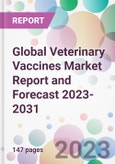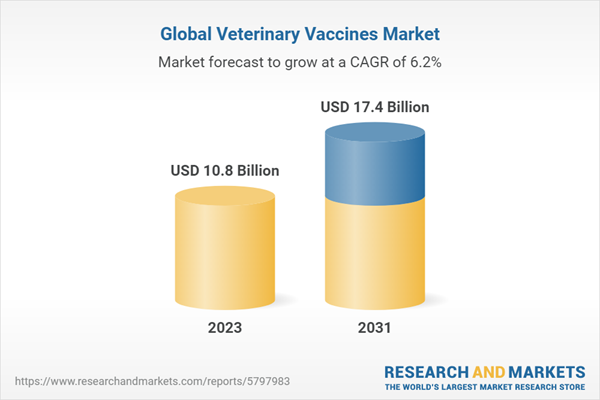The global veterinary vaccines market value was USD 10.1 billion in 2022, driven by the rising prevalence of zoonotic diseases structure across the globe. The market size is anticipated to grow at a CAGR of 6.2% during the forecast period of 2023-2031 to achieve a value of USD 17.4 billion by 2031.
The global veterinary vaccines market is experiencing significant growth due to factors such as the increasing demand for livestock products, the rising prevalence of zoonotic diseases, growing pet ownership, and the need for effective disease prevention in animals. Technological advancements in vaccine development, such as recombinant vaccines and DNA vaccines, are further driving the market. Additionally, government initiatives and investments in veterinary healthcare and research are contributing to the market's expansion.
North America: The largest market for veterinary vaccines, driven by factors such as advanced veterinary healthcare infrastructure, the presence of leading vaccine manufacturers, and a high focus on animal health and welfare.
Europe: The second-largest market, with increasing demand for veterinary vaccines due to a growing emphasis on food safety, animal welfare, and government support for research and development.
Asia-Pacific: Expected to witness the highest growth rate due to factors such as a rapidly growing livestock industry, increasing pet ownership, and growing investments in veterinary healthcare infrastructure and research.
Veterinary Vaccines Introduction
Veterinary vaccines are essential for preventing and controlling infectious diseases in animals, ensuring animal health and welfare, and safeguarding public health. These vaccines play a crucial role in maintaining the health of livestock, poultry, and companion animals by stimulating their immune systems to produce a specific immune response against pathogens. Veterinary vaccines also help improve animal productivity and reduce the use of antibiotics, contributing to the fight against antimicrobial resistance.The global veterinary vaccines market is experiencing significant growth due to factors such as the increasing demand for livestock products, the rising prevalence of zoonotic diseases, growing pet ownership, and the need for effective disease prevention in animals. Technological advancements in vaccine development, such as recombinant vaccines and DNA vaccines, are further driving the market. Additionally, government initiatives and investments in veterinary healthcare and research are contributing to the market's expansion.
Veterinary Vaccines Market Scenario
The global veterinary vaccines market is poised for significant growth as the demand for effective disease prevention in animals continues to rise. Factors such as the increasing demand for livestock products, the rising prevalence of zoonotic diseases, and technological advancements in vaccine development contribute to the market's expansion. The market is characterized by regional dynamics shaped by veterinary healthcare infrastructure, government support, and investment in research and development. However, challenges such as the high cost of vaccine development, limited access to vaccines in low- and middle-income countries, and the need for maintaining cold chain logistics may impact market growth.North America: The largest market for veterinary vaccines, driven by factors such as advanced veterinary healthcare infrastructure, the presence of leading vaccine manufacturers, and a high focus on animal health and welfare.
Europe: The second-largest market, with increasing demand for veterinary vaccines due to a growing emphasis on food safety, animal welfare, and government support for research and development.
Asia-Pacific: Expected to witness the highest growth rate due to factors such as a rapidly growing livestock industry, increasing pet ownership, and growing investments in veterinary healthcare infrastructure and research.
Veterinary Vaccines Market Segmentations
Market Breakup by Type
- Live Attenuated Vaccines
- Inactivated Vaccines
- Toxoid Vaccines
- DNA Vaccines
- Recombinant Vaccines
- Other Vaccines
Market Breakup by Animal Type
- Porcine
- Poultry
Livestock
- Bovine
- Small Ruminant
Companion Animal
- Canine
- Feline
- Aquaculture
- Others
Market Breakup by Route of Administration
- Oral
- Parenteral
- Topical
Market Breakup by End User
- Veterinary Hospitals
- Veterinary Clinics
- Poultry Farms
- Animal Farms
- Others
Market Breakup by Distribution Channel
- Online Stores
- Pharmacies and Drug Stores
- Others
Market Breakup by Region
North America
- United States of America
- Canada
Europe
- United Kingdom
- Germany
- France
- Italy
- Others
Asia Pacific
- China
- Japan
- India
- ASEAN
- Australia
- Others
Latin America
- Brazil
- Argentina
- Mexico
- Others
Middle East and Africa
- Saudi Arabia
- United Arab Emirates
- Nigeria
- South Africa
- Others
Key Trends in the Veterinary Vaccines Market
Some key trends of the market are as follows:- Increasing demand for livestock products: The rising demand for livestock products, such as meat, milk, and eggs, is driving the need for effective vaccines to ensure the health and productivity of livestock animals
- Growing prevalence of zoonotic diseases: The increasing occurrence of zoonotic diseases, which can be transmitted between animals and humans, is prompting the adoption of veterinary vaccines to protect public health
- Technological advancements in vaccine development: The introduction of advanced vaccine technologies, such as recombinant and DNA vaccines, has improved the efficacy and safety of veterinary vaccines, leading to increased adoption
Competitor Landscape
The key features of the market report include patent analysis, grants analysis, clinical trials analysis, funding and investment analysis, partnerships, and collaborations analysis by the leading key players. The major companies in the Veterinary Vaccines market are as follows:- Bayer AG
- Sanofi
- Pfizer Inc
- GSK plc
- Merck & Co., Inc
- Ceva
- Cargill, Incorporated
- Boehringer Ingelheim International GmbH
- Takeda Pharmaceutical Company Limited
- Zoetis
- Dechra Pharmaceuticals PLC
- Hester Biosciences Limited
- Elanco
- Phibro Animal Health Corporation
- Indovax
Table of Contents
1 Preface
3 Global Veterinary Vaccines Market Overview
4 Global Veterinary Vaccines Market Landscape
5 Global Veterinary Vaccines Market Dynamics
6 Global Veterinary Vaccines Market Segmentation
7 North America Veterinary Vaccines Market
8 Europe Veterinary Vaccines Market
9 Asia Pacific Veterinary Vaccines Market
10 Latin America Veterinary Vaccines Market
11 Middle East and Africa Veterinary Vaccines Market
12 Patent Analysis
13 Grants Analysis
14 Clinical Trials Analysis
15 Funding Analysis
16 Partnership and Collaborations Analysis
17 Regulatory Framework
18 Supplier Landscape
19 Global Veterinary Vaccines Market - Distribution Model (Additional Insight)
21 Company Competitiveness Analysis (Additional Insight)
22 Payment Methods (Additional Insight)
Companies Mentioned
- Bayer AG
- Sanofi
- Pfizer Inc.
- Gsk plc.
- Merck & Co. Inc.
- Ceva
- Cargill, Incorporated
- Boehringer Ingelheim International Gmbh.
- Takeda Pharmaceutical Company Limited
- Zoetis
- Dechra Pharmaceuticals plc
- Hester Biosciences Limited.
- Elanco
- Phibro Animal Health Corporation
- Indovax
Methodology

LOADING...
Table Information
| Report Attribute | Details |
|---|---|
| No. of Pages | 147 |
| Published | May 2023 |
| Forecast Period | 2023 - 2031 |
| Estimated Market Value ( USD | $ 10.8 Billion |
| Forecasted Market Value ( USD | $ 17.4 Billion |
| Compound Annual Growth Rate | 6.2% |
| Regions Covered | Global |
| No. of Companies Mentioned | 15 |









